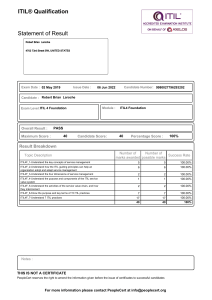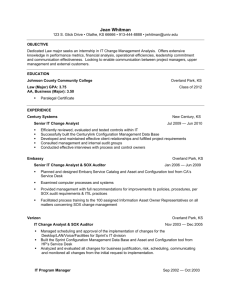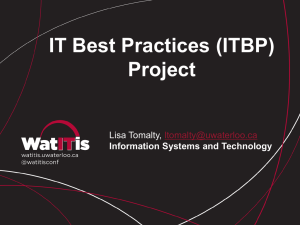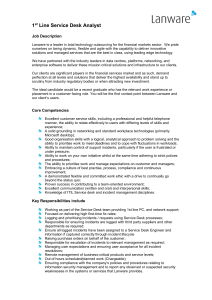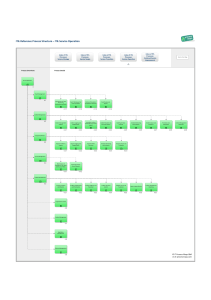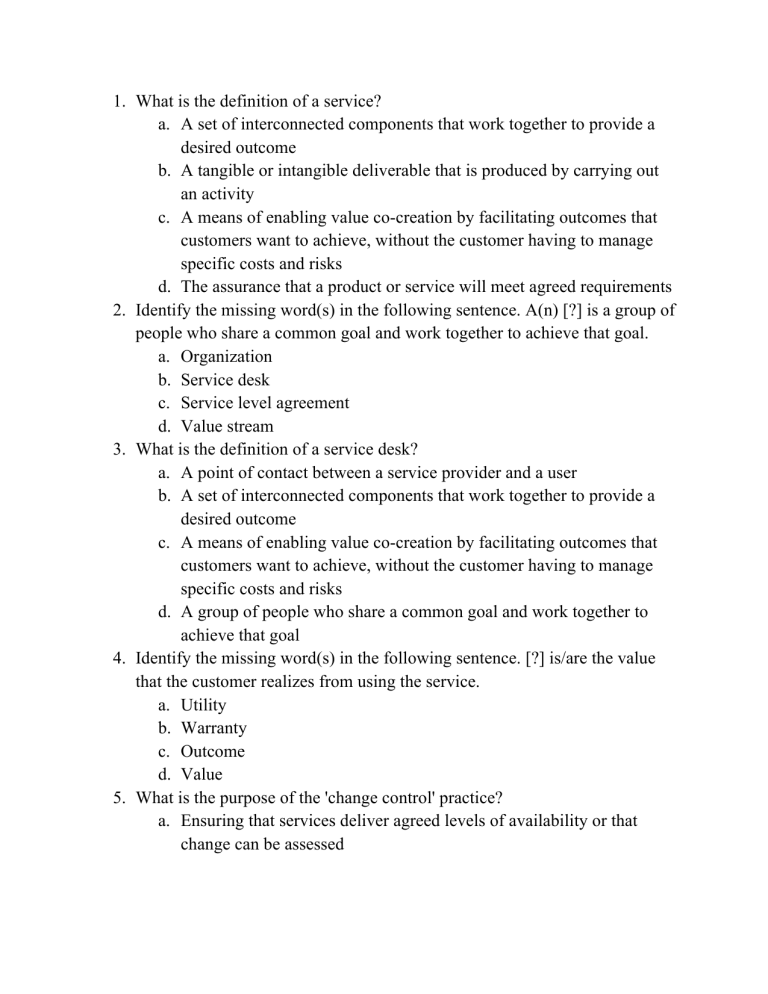
1. What is the definition of a service? a. A set of interconnected components that work together to provide a desired outcome b. A tangible or intangible deliverable that is produced by carrying out an activity c. A means of enabling value co-creation by facilitating outcomes that customers want to achieve, without the customer having to manage specific costs and risks d. The assurance that a product or service will meet agreed requirements 2. Identify the missing word(s) in the following sentence. A(n) [?] is a group of people who share a common goal and work together to achieve that goal. a. Organization b. Service desk c. Service level agreement d. Value stream 3. What is the definition of a service desk? a. A point of contact between a service provider and a user b. A set of interconnected components that work together to provide a desired outcome c. A means of enabling value co-creation by facilitating outcomes that customers want to achieve, without the customer having to manage specific costs and risks d. A group of people who share a common goal and work together to achieve that goal 4. Identify the missing word(s) in the following sentence. [?] is/are the value that the customer realizes from using the service. a. Utility b. Warranty c. Outcome d. Value 5. What is the purpose of the 'change control' practice? a. Ensuring that services deliver agreed levels of availability or that change can be assessed 6. 7. 8. 9. b. Setting clear business-based targets for service performance so that the delivery of a service can be properly assessed, monitored, and managed against these targets c. Minimizing the negative impact of incidents by restoring normal service operation as quickly as possible d. Enabling the organization to make beneficial changes to a service with minimal disruption to services What is the purpose of the 'release management' practice? a. Ensuring that services deliver agreed levels of availability or that change can be assessed b. Setting clear business-based targets for service performance so that the delivery of a service can be properly assessed, monitored, and managed against these targets c. Enabling the organization to make beneficial changes to a service with minimal disruption to services d. Minimizing the negative impact of incidents by restoring normal service operation as quickly as possible Identify the missing word(s) in the following sentence. A [?] is a document that identifies all the individual pieces of an IT service. a. Service level agreement b. Configuration item c. Incident report d. Change request What is the definition of a problem? a. An unplanned interruption to an IT service or a reduction in the quality of an IT service b. A possible event that could cause harm or loss, or make it more difficult to achieve objectives c) The underlying cause of one or more incidents c. A request from a user for information, advice, or for a standard change Identify the missing word(s) in the following sentence. Service [?] is the practice of ensuring that services deliver agreed levels of availability or that change can be assessed, mitigated, or prevented. a. Level Management b. Capacity and performance management c. Request management d. Availability management 10. Which of the following is not an objective of the service desk? a. Restoring service as quickly as possible b. Handling all service requests effectively and efficiently c. Improving overall customer satisfaction with IT services d. Developing and maintaining a comprehensive knowledge management system 11. What is the definition of an incident? a. Any event that is not part of the standard operation of a service and which causes or may cause disruption to or a reduction in the quality of services b. A request from a user for information, advice, or for a standard change or access to an IT service c. A significant change in the status of a CI, service, or IT infrastructure component that needs to be recorded d. A pre-defined change that is low risk, relatively common, and follows a procedure or work instruction 12. Which of the following is not a purpose of the change management practice? a. To ensure that changes are made in a standardized and efficient manner b. To minimize the impact of incidents caused by changes c. To ensure that changes are only made in response to a customer request d. To optimize overall business value through the effective and efficient handling of changes 13. Which of the following best describes the purpose of the continual improvement practice? a. To align the organization's practices and services with changing business needs b. To ensure that services deliver agreed levels of availability or that change can be assessed c. To minimize the negative impact of incidents by restoring normal service operation as quickly as possible d. To identify improvement opportunities in all aspects of the organization's practices and services 14. Which of the following is not a stage of the service value system? a. Plan b. Improve c. Deliver d. Monitor 15. Which of the following is not a dimension of service management? a. Organizations and people b. Value streams and processes c. Partners and suppliers d. Technology and infrastructure 16. What is the definition of a change? a. An event that is not part of the standard operation of a service and which causes or may cause disruption to or a reduction in the quality of services b. A request from a user for information, advice, or for a standard change or access to an IT service c. A significant change in the status of a CI, service, or IT infrastructure component that needs to be recorded d. The addition, modification, or removal of anything that could have an effect on IT services 17. Which of the following is not a practice within the service value chain? a. Service desk b. Service-level management c. Incident management d. Problem management 18. What is the purpose of the 'service level management' practice? a. To set clear business-based targets for service performance so that the delivery of a service can be properly assessed, monitored, and managed against these targets b. To minimize the negative impact of incidents by restoring normal service operation as quickly as possible c. To ensure that an organization's suppliers and their performance levels are managed appropriately to support the provision of seamless quality products and services d. To establish and nurture links between an organization and its stakeholders at strategic and tactical levels 19. Which of the following is the purpose of the 'change enablement' practice? a. Ensuring that services deliver agreed levels of availability or that change can be assessed b. Setting clear business-based targets for service performance so that the delivery of a service can be properly assessed, monitored, and managed against these targets c. Establishing and nurturing links between an organization and its stakeholders at strategic and tactical levels d. Enabling the organization to make beneficial changes quickly and reliably at lower risk by ensuring that the right people are involved in change-related decisions and activities, and by ensuring that changes are recorded and evaluated. 20. What is the purpose of the 'service desk' practice? a. Reducing the likelihood and impact of incidents by identifying actual and potential causes of incidents, and managing workarounds and known errors b. Providing a single point of contact between service providers and users c. Setting clear business-based targets for service performance so that the delivery of a service can be properly assessed, monitored, and managed against these targets d. Enabling the organization to make beneficial changes quickly and reliably at lower risk by ensuring that the right people are involved in change-related decisions and activities, and by ensuring that changes are recorded and evaluated. 21. Identify the missing word(s) in the following sentence. [?] management is the practice of maintaining information about configuration items required to deliver an IT service, including their relationships. a. Service level b. Change c. Release d. Configuration 22. What is the definition of a 'service request'? a. A formal proposal for a new service or a significant change to an existing service b. A request from a user for information, advice, a standard change, or access to an IT service c. An issue reported by a user that needs to be resolved in order to restore normal service operation d. A plan that details the steps to be taken to manage a significant change to an IT service or IT infrastructure 23. What is the definition of a 'service level agreement' (SLA)? a. A document that describes the requirements for a new service or a significant change to an existing service b. A formal agreement between a service provider and their customer(s) that defines the key service targets, responsibilities, and dependencies of the service provider and customer(s) c. A plan that details the steps to be taken to manage a significant change to an IT service or IT infrastructure d. A document that describes the specific targets for service performance that will be used to measure and report on the actual performance of a service 24. Identify the missing word(s) in the following sentence. Service [?] management is the practice of managing the capacity and performance of IT services and IT infrastructure. a. Level b. Asset c. Request d. Capacity and performance 25. What is the purpose of the 'incident management' practice? a. Ensuring that services deliver agreed levels of availability or that change can be assessed b. Reducing the likelihood and impact of incidents by identifying actual and potential causes of incidents, and managing workarounds and known errors c. Providing a single point of contact between service providers and users d. Minimizing the negative impact of incidents by restoring normal service operation as quickly as possible 26. Which ITIL practice helps organizations deliver value through the use of services? a. Service level management b. Service design c. Service management d. Service operation 27. Which stage of the ITIL service lifecycle is responsible for ensuring that services are designed, developed, and implemented according to business requirements? a. Service transition b. Service operation c. Service design d. Service Strategy 28. Which ITIL practice provides guidance on the use of metrics and measurements? a. Service level management b. Continual service improvement c. Service desk d. Service operation 29. Which ITIL practice helps organizations identify, prioritize, and manage risks? a. Service level management b. Continual service improvement c. Risk management d. Service operation 30. Which ITIL practice is responsible for managing the flow of information between the service provider and the customer? a. Service desk b. Service level management c. Service transition d. Service operation 31. Which ITIL practice is responsible for ensuring that services are delivered according to agreed-upon service levels? a. Service level management b. Service desk c. Service transition d. Service operation 32. Which ITIL practice provides guidance on the development and improvement of the skills and knowledge of IT staff? a. Service level management b. Continual service improvement c. Service desk d. Service operation 33. Which stage of the ITIL service lifecycle is responsible for the ongoing management and improvement of services? a. Service transition b. Service strategy c. Continual service improvement d. Service operation 34. Which ITIL practice is responsible for managing the availability of services? a. Service level management b. Availability management c. Service desk d. Service operation 35. Which ITIL practice helps organizations manage the cost of services? a. Service desk b. Service level management c. Service operation d. financial management for IT services 36. Which of the following is NOT one of the four dimensions of ITIL 4? a. Organizations and people b. Information and technology c. Partners and suppliers d. Service processes 37. Which dimension of ITIL 4 refers to the culture, structure, and policies of an organization? a. Organizations and people b. Information and technology c. Partners and suppliers d. Value streams and processes 38. Which dimension of ITIL 4 is concerned with the management of data and information used by an organization? a. Organizations and people b. Information and technology c. Partners and suppliers d. Value streams and processes 39. Which dimension of ITIL 4 includes the management of relationships with external organizations? a. Organizations and people b. Information and technology c. Partners and suppliers d. Value streams and processes 40. Which of the following is a key component of the dimension "value streams and processes" in ITIL 4? a. Incident management b. Change management c. Continuous improvement d. Problem management 41. Which of the following is the first step in the Service Value Chain? a. Plan b. Engage c. Design and transition d. Improve 42. Which of the following is NOT a component of the Service Value System? a. Guiding Principles b. Governance c. Service Value Chain d. Service Management Tools and Techniques 43. Which of the following is a benefit of the Service Value System? a. Increased flexibility b. Reduced costs c. Improved customer satisfaction d. All of the above 44. Which of the following stages of the Service Value Chain is responsible for ensuring that services are delivered in a reliable and efficient manner? a. Plan b. Improve c. Deliver and support d. Engage 45. Which of the following is NOT a primary activity in the Service Value Chain? a. Plan b. Engage c. Obtain/build d. Monitor 46. Which ITIL management practice focuses on aligning IT service management with the needs of the business? a. Service Level Management b. Service Request Management c. Business Relationship Management d. Change Enablement Management 47. Which ITIL management practice focuses on maintaining and improving the performance and reliability of IT services? a. Service Configuration Management b. Availability Management c. Incident Management d. Problem Management 48. Which ITIL management practice focuses on the management of physical and virtual infrastructure components? a. IT Asset Management b. IT Operations Management c. Release Management d. Service Desk Management 49. Which ITIL management practice focuses on the management of changes to IT services and infrastructure? a. Change Enablement Management b. Service Request Management c. Release Management d. Service Level Management 50. Which ITIL management practice focuses on the management of relationships between IT service providers and their customers? a. Business Relationship Management b. Service Level Management c. Service Request Management d. Demand Management

